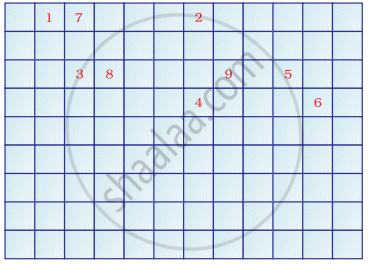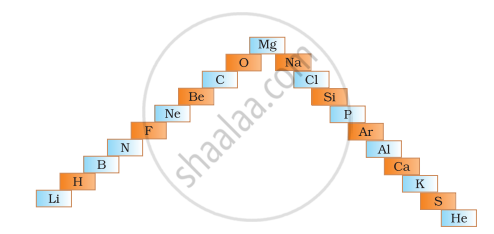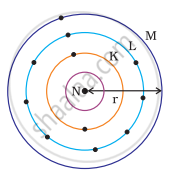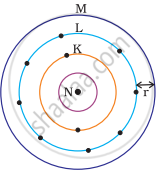Advertisements
Online Mock Tests
Chapters
2: Acids, Bases and Salts
3: Metals and Non-metals
4: Carbon and its Compounds
▶ 5: Periodic Classification of Elements
6: Life Processes
7: Control and Coordination
8: How do Organisms Reproduce?
9: Heredity and Evolution
10: Light – Reflection and Refraction
11: The Human Eye and the Colourful World
12: Electricity
13: Magnetic Effects of Electric Current
14: Sources of Energy
15: Our Environment
16: Management of Natural Resources
![NCERT Exemplar solutions for Science [English] Class 10 chapter 5 - Periodic Classification of Elements NCERT Exemplar solutions for Science [English] Class 10 chapter 5 - Periodic Classification of Elements - Shaalaa.com](/images/science-english-class-10_6:5f2b1b2038084cf381bfa42c826a928c.jpg)
Advertisements
Solutions for Chapter 5: Periodic Classification of Elements
Below listed, you can find solutions for Chapter 5 of CBSE NCERT Exemplar for Science [English] Class 10.
NCERT Exemplar solutions for Science [English] Class 10 5 Periodic Classification of Elements Multiple Choice Questions [Pages 38 - 43]
Upto which element, the Law of Octaves was found to be applicable
Oxygen
Calcium
Cobalt
Potassium
According to Mendeléev's Periodic Law, the elements were arranged in the periodic table in the order of
increasing atomic number
decreasing atomic number
increasing atomic masses
decreasing atomic masses
In Mendeléev’s Periodic Table, gaps were left for the elements to be discovered later. Which of the following elements found a place in the periodic table later
Germanium
Chlorine
Oxygen
Silicon
Which of the following statement (s) about the Modern Periodic Table are incorrect
- The elements in the Modern Periodic Table are arranged on the basis of their decreasing atomic number
- The elements in the Modern Periodic Table are arranged on the basis of their increasing atomic masses
- Isotopes are placed in adjoining group (s) in the Periodic Table
- The elements in the Modern Periodic Table are arranged on the basis of their increasing atomic number
(i) only
(i), (ii) and (iii)
(i), (ii) and (iv)
(iv) only
Which of the following statements about the Modern Periodic Table is correct:
It has 18 horizontal rows known as Periods
It has 7 vertical columns known as Periods
It has 18 vertical columns known as Groups
It has 7 horizontal rows known as Groups
Which of the given elements A, B, C, D and E with atomic number 2, 3, 7, 10 and 30 respectively belong to the same period?
A, B, C
B, C, D
A, D, E
A, D, E
The elements A, B, C, D and E have atomic number 9, 11, 17, 12 and 13 respectively. Which pair of elements belong to the same group?
A and B
B and D
A and C
D and E
Where would you locate the element with electronic configuration 2,8 in the Modern Periodic Table?
Group 8
Group 2
Group 18
Group 10
An element which is an essential constituent of all organic compounds belongs to
group 1
group 14
group 15
group 16
Which of the following is the outermost shell for elements of period 2?
K shell
L shell
M shell
N shell
Which one of the following elements exhibit maximum number of valence electrons?
Na
Al
Si
P
Which of the following gives the correct increasing order of the atomic radii of O, F and N?
O, F, N
N, F, O
O, N, F
F, O, N
Which among the following elements has the largest atomic radii?
Na
Mg
K
Ca
Which of the following elements would lose an electron easily?
Mg
Na
K
Ca
Which of the following elements does not lose an electron easily?
Na
F
Mg
Al
Which of the following are the characteristics of isotopes of an element?
- Isotopes of an element have same atomic masses
- Isotopes of an element have same atomic number
- Isotopes of an element show same physical properties
- Isotopes of an element show same chemical properties
(i), (iii) and (iv)
(ii), (iii) and (iv)
(ii) and (iii)
(ii) and (iv)
Arrange the following elements in the order of their decreasing metallic character
Na, Si, Cl, Mg, Al
Cl > Si >Al > Mg >Na
Na >Mg >Al >Si > Cl
Na > Al > Mg > Cl > Si
Al > Na> Si > Ca> Mg
Arrange the following elements in the order of their increasing nonmetallic character
Li, O, C, Be, F
F < O < C < Be < Li
Li < Be < C < O< F
F < O < C < Be < Li
F < O < Be < C < Li
What type of oxide would Eka– aluminium form?
EO3
E3 O2
E2 O3
EO
Three elements B, Si and Ge are
metals
non-metals
metalloids
metal, non-metal and metalloid respectively
Which of the following elements will form an acidic oxide?
An element with atomic number 7
An element with atomic number 3
An element with atomic number 12
An element with atomic number 19
The element with atomic number 14 is hard and forms acidic oxide and a covalent halide. To which of the following categories does the element belong?
Metal
Metalloid
Non-metal
Left-hand side element
Which one of the following depict the correct representation of atomic radius(r) of an atom?
|
(i) |
(ii) |
|
(iii) |
(iv) |
(i) and (ii)
(ii) and (iii)
(iii) and (iv)
(i) and (iv)
Which one of the following does not increase while moving down the group of the periodic table?
Atomic radius
Metallic character
Valence
Number of shells in an element
On moving from left to right in a period in the periodic table, the size of the atom.
increases
decreases
does not change appreciably
first decreases and then increases
Which of the following set of elements is written in order of their increasing metallic character?
Be Mg Ca
Na Li K
Mg Al Si
C O N
NCERT Exemplar solutions for Science [English] Class 10 5 Periodic Classification of Elements Short Answer Questions [Pages 43 - 44]
The three elements A, B and C with similar properties have atomic masses X, Y and Z respectively. The mass of Y is approximately equal to the average mass of X and Z. What is such an arrangement of elements called as? Give one example of such a set of elements.
Elements have been arranged in the following sequence on the basis of their increasing atomic masses.
| F, | Na, | Mg, | Al, | Si, | P, | S, | Cl, | Ar, | K |
- Pick two sets of elements which have similar properties.
- The given sequence represents which law of classification of elements?
Can the following groups of elements be classified as Döbereiner's triad?
- Na, Si, Cl
- Be, Mg, Ca
Atomic mass of Be 9; Na 23; Mg 24; Si 28; Cl 35; Ca 40 Explain by giving reason.
In Mendeléev’s Periodic Table the elements were arranged in the increasing order of their atomic masses. However, cobalt with atomic mass of 58.93 amu was placed before nickel having an atomic mass of 58.71 amu. Give reason for the same.
“Hydrogen occupies a unique position in Modern Periodic Table”. Justify the statement.
Write the formulae of chlorides of Eka-silicon and Eka-aluminium, the elements predicted by Mendeléev.
Three elements A, B and C have 3, 4 and 2 electrons respectively in their outermost shell. Give the group number to which they belong in the Modern Periodic Table. Also, give their valencies.
If an element X is placed in group 14, what will be the formula and the nature of bonding of its chloride?
Compare the radii of two species X and Y. Give reasons for your answer.
- X has 12 protons and 12 electrons
- Y has 12 protons and 10 electrons
Arrange the following elements in increasing order of their atomic radii.
- Li, Be, F, N
- Cl, At, Br I
Identify and name the metals out of the following elements whose electronic configurations are given below.
- 2, 8, 2
- 2, 8, 1
- 2, 8, 7
- 2, 1
Write the formula of the product formed when the element A (atomic number 19) combines with the element B (atomic number 17). Draw its electronic dot structure. What is the nature of the bond formed?
Arrange the following elements in the increasing order of their metallic character
| Mg, | Ca, | K, | Ge, | Ga |
Identify the elements with the following property and arrange them in increasing order of their reactivity
- An element which is a soft and reactive metal
- The metal which is an important constituent of limestone
- The metal which exists in liquid state at room temperature
Properties of the elements are given below. Where would you locate the following elements in the periodic table?
- A soft metal stored under kerosene
- An element with variable (more than one) valency stored under water.
- An element which is tetravalent and forms the basis of organic chemistry
- An element which is an inert gas with atomic number 2
- An element whose thin oxide layer is used to make other elements corrosion resistant by the process of “ anodising”
NCERT Exemplar solutions for Science [English] Class 10 5 Periodic Classification of Elements Long Answer Questions [Pages 45 - 47]
An element is placed in 2nd Group and 3rd Period of the Periodic Table, burns in presence of oxygen to form a basic oxide.
- Identify the element
- Write the electronic configuration
- Write the balanced equation when it burns in the presence of air
- Write a balanced equation when this oxide is dissolved in water
- Draw the electron dot structure for the formation of this oxide
An element X (atomic number 17) reacts with an element Y (atomic number 20) to form a divalent halide.
- Where in the periodic table are elements X and Y placed?
- Classify X and Y as metal (s), non-metal (s) or metalloid (s)
- What will be the nature of oxide of element Y? Identify the nature of bonding in the compound formed
- Draw the electron dot structure of the divalent halide
Atomic number of a few elements are given below
10, 20, 7, 14
- Identify the elements
- Identify the Group number of these elements in the Periodic Table
- Identify the Periods of these elements in the Periodic Table
- What would be the electronic configuration for each of these elements?
- Determine the valency of these elements
Complete the following cross word puzzle
Across:
(1) An element with atomic number 12.
(3) Metal used in making cans and member of Group 14.
(4) A lustrous non-metal which has 7 electrons in its outermost shell.
Down:
(2) Highly reactive and soft metal which imparts yellow colour when subjected to flame and is kept in kerosene.
(5) The first element of second Period
(6) An element which is used in making fluorescent bulbs and is second member of Group 18 in the Modern Periodic Table
(7) A radioactive element which is the last member of halogen family.
(8) Metal which is an important constituent of steel and forms rust when exposed to moist air.
(9) The first metalloid in Modern Periodic Table whose fibres are used in making bullet-proof vests

- In below ladder symbols of elements are jumbled up. Rearrange these symbols of elements in the increasing order of their atomic number in the Periodic Table.
- Arrange them in the order of their group also.

Mendeléev predicted the existence of certain elements not known at that time and named two of them as Eka-silicon and Eka-aluminium.
- Name the elements which have taken the place of these elements
- Mention the group and the period of these elements in the Modern Periodic Table.
- Classify these elements as metals, non-metals or metalloids
- How many valence electrons are present in each one of them?
- Electropositive nature of the element(s) increases down the group and decreases across the period
- Electronegativity of the element decreases down the group and increases across the period
- Atomic size increases down the group and decreases across a period (left to right)
- Metallic character increases down the group and decreases across a period.
On the basis of the above trends of the Periodic Table, answer the following about the elements with atomic numbers 3 to 9.
- Name the most electropositive element among them
- Name the most electronegative element
- Name the element with smallest atomic size
- Name the element which is a metalloid
- Name the element which shows maximum valency.
An element X which is a yellow solid at room temperature shows catenation and allotropy. X forms two oxides which are also formed during the thermal decomposition of ferrous sulphate crystals and are the major air pollutants.
- Identify the element X
- Write the electronic configuration of X
- Write the balanced chemical equation for the thermal decomposition of ferrous sulphate crystals?
- What would be the nature (acidic/ basic) of oxides formed?
- Locate the position of the element in the Modern Periodic Table.
An element X of group 15 exists as diatomic molecule and combines with hydrogen at 773 K in presence of the catalyst to form a compound, ammonia which has a characteristic pungent smell.
- Identify the element X. How many valence electrons does it have?
- Draw the electron dot structure of the diatomic molecule of X. What type of bond is formed in it?
- Draw the electron dot structure for ammonia and what type of bond is formed in it?
Which group of elements could be placed in Mendeléev's Periodic Table without disturbing the original order? Give reason.
Give an account of the process adopted by Mendeléev for the classification of elements. How did he arrive at “Periodic Law”?
Solutions for 5: Periodic Classification of Elements
![NCERT Exemplar solutions for Science [English] Class 10 chapter 5 - Periodic Classification of Elements NCERT Exemplar solutions for Science [English] Class 10 chapter 5 - Periodic Classification of Elements - Shaalaa.com](/images/science-english-class-10_6:5f2b1b2038084cf381bfa42c826a928c.jpg)
NCERT Exemplar solutions for Science [English] Class 10 chapter 5 - Periodic Classification of Elements
Shaalaa.com has the CBSE Mathematics Science [English] Class 10 CBSE solutions in a manner that help students grasp basic concepts better and faster. The detailed, step-by-step solutions will help you understand the concepts better and clarify any confusion. NCERT Exemplar solutions for Mathematics Science [English] Class 10 CBSE 5 (Periodic Classification of Elements) include all questions with answers and detailed explanations. This will clear students' doubts about questions and improve their application skills while preparing for board exams.
Further, we at Shaalaa.com provide such solutions so students can prepare for written exams. NCERT Exemplar textbook solutions can be a core help for self-study and provide excellent self-help guidance for students.
Concepts covered in Science [English] Class 10 chapter 5 Periodic Classification of Elements are History of Periodic Table: Early Attempts at the Classification of Elements, Dobereiner’s Triads, Newland's Law of Octaves, Periodic Properties, Mendeleev’s Periodic Table, Merits and Demerits of Mendeleev’s Periodic Table, The Modern Periodic Table, Valency, Atomic Radius Or Atomic Size, Metallic and Non-metallic Characters.
Using NCERT Exemplar Science [English] Class 10 solutions Periodic Classification of Elements exercise by students is an easy way to prepare for the exams, as they involve solutions arranged chapter-wise and also page-wise. The questions involved in NCERT Exemplar Solutions are essential questions that can be asked in the final exam. Maximum CBSE Science [English] Class 10 students prefer NCERT Exemplar Textbook Solutions to score more in exams.
Get the free view of Chapter 5, Periodic Classification of Elements Science [English] Class 10 additional questions for Mathematics Science [English] Class 10 CBSE, and you can use Shaalaa.com to keep it handy for your exam preparation.




